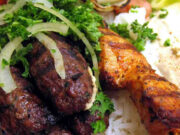Tina Walsh visits Gaziantep, considered by Turks to be the world capital of baklava
The mercury is nudging 40°C and I’m standing in the middle of an industrial-sized kitchen, sporting a voluminous, white baker’s jacket, hairnet and pale blue plastic shoe covers.
I’ve come to Gaziantep in south-east Turkey to visit the Güllüoglu bakery, one of the country’s best-known baklava producers, with outlets in Paris, New York and Athens, to see how they make the famous syrupy dessert. So prized is Gaziantep baklava (as are the pistachios grown on farms around the town) that earlier this year it was awarded ‘protected status’ by the European Union.
As we make our way round the building, my guide and local food expert, Filiz Hösükoğlu, translates while owner Omer Güllüoglu explains each stage of the process, from rolling out the filo pastry until it’s gossamer thin, filling it with pistachio nuts and syrup (honey is for amateurs, I’m told) to baking it in the wood-fired oven.
There are claimed to be 180 or more baklava shops
in Gaziantep (known locally as Antep), one of the world’s
oldest continuously inhabited cities, dating back to the Hittites in 1600BC and situated on the old Silk Road trading route.
“It takes 15 years to become a master baker,” says Mr Güllüoglu, a genial man in his early fifties. “We still make baklava the way my grandfather made it back in the 1920s, without much modern technology. Not many bakers in Turkey do that.” As if on cue, an elderly man in a crocheted kufi (Islamic cap) appears tentatively from behind an oven and peers at us. “Mustafa has been here since I was a baby,” says his boss, fondly.
Foreign visitors often overlook Turkey’s south-east region in favour of Istanbul and the bigger Mediterranean resorts but they are missing a trick. Not only is it packed with ancient archaeological sites but it has a long and proud culinary history. Passed down by the Ottomans, whose empire at its height in the 16th and 17th centuries spanned three continents, the region’s influences come from Asia, south-eastern Europe, the Middle East and North Africa.
After testing the finished baklava – a light, crispy golden brown dollop that melts in the mouth – Filiz and I make our way to Gaziantep’s Elmaci Pazari (Apple Bazaar) in the old part of the city. Like all Turkish food markets, it’s a kaleidoscope of colours, smells and textures unfamiliar to most west Europeans. People in Gaziantep cook food in the traditional way, using lots of fresh produce and seasonal ingredients. “Cooking here is considered an art,” Filiz tells me, as we walk past shop fronts piled high with flame red chilli flakes, figs, olives and mounds of unpronounceable, brightly coloured spices.A two-and-a-half hour drive west of Gaziantep, towards the Mediterranean coast, lies the ancient city of Tarsus, birthplace of St Paul the Apostle.
During the Roman Empire, Tarsus was the capital of the province of Cilicia, scene of the first meeting between Mark Antony and Cleopatra. You can still see part of the Roman road – unearthed by accident during construction work in the early 1990s – where the ill-fated lovers are said to have held their trysts.
Today, the town is a collection of cobbled streets and old Ottoman wooden houses, many of them being renovated or turned into boutique hotels in time for the opening of Tarsus’ first international airport in 2017.
In the little bazaar, I stop to look at an exquisitely crafted silver bracelet and am invited to try some kaynar. A Tarsus speciality, this hot drink is made from ginger, sugar, water and spices and is surprisingly refreshing.
Once past Mersin, a large port city on the Mediterranean coast about 40 minutes south west of Tarsus, there are plenty of places to swim and sunbathe Narlikuyu, a pretty coastal village 40 miles south of Mersin, has a handful of popular seafood restaurants dotted round a sheltered harbour. Taking a dip here is an experience: the clear, turquoise water is fed by an underground stream from the nearby Cennet and Cehennem (Heaven and Hell) caves and is, by turns, deliciously warm and freezing cold. A group of Turkish tourists (there’s hardly a foreign one in sight) are yelping and splashing around, gesturing to their friends feasting on buttered prawns, grouper fish and battered calamari on the rocky promontory, to come and join them.
As I slip, replete, from my own table into the water, I promise myself I’ll come back to south east Turkey before long to discover more of what’s on the menu.
Eat like a local
Local dishes to try include lahmacun (pronounced la-ma-jun), a thin, round flatbread coated with diced minced lamb, spices, chopped tomatoes and green pepper; simit kebab, kebab made with fine grain bulgur wheat, pistachio nuts, minced lamb and garlic; and damat dolmasi, baby courgettes stuffed with lamb, almonds, rice and pistachios.
WAY TO GO
Pegasus Airlines(Tel: 0845 0848 980 / flypgs.com) operates flights from Stansted to Gaziante via
Istanbul and Izmir.
Culinary Backstreets (culinarybackstreets.com) offers a three-day food tour of Gaziantep from $1,100 (£680) per person, including food and drink, private transfers and accommodation.
For other options along the Mediterranean coast, Ramblers Holidays offers several package tours, including walking (Tel: 01707 331133 / ramblersholidays.co.uk) while several operators feature the Lycian Way, including Headwater (Tel: 01606 828560 / headwater.com) and The Discovery Collection (Tel: 01371 859 733 / discovery-collection.com).















